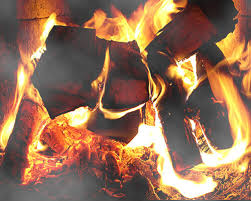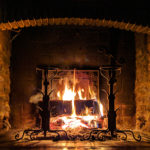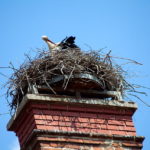Diagnosing the Most Common Causes of Smoke in a Wood-Burning Fireplace
As catchy as it is, the classic Talking Heads song “Burning Down the House” should not describe how your fireplace works.
When smoke starts billowing back down the flue or coming out of the firebox, you’ve got a problem.
Smoke isn’t just bad for your lungs, it’s also a sign that your fireplace and chimney aren’t working efficiently.
But what causes an excessively smoky fireplace? Let’s take a closer look at some of the top reasons for this common problem and what you can do to address them.
Why Is Your Fireplace Smoking?
A smoking fireplace is the result of chimney draft issues. In this context, draft refers to how the air flows up the chimney.
Indoor air pressure affects this air flow. The air inside your home pushes air up the chimney, like a vacuum.
Good draft conditions allow vented smoke to travel up the chimney quickly, while poor draft conditions can cause smoke to billow back out into your home instead.
Common causes of poor draft conditions include:
1 – A Well-Insulated House
This might seem counterintuitive; after all, an airtight, well-insulated home is great for your comfort and energy bills… isn’t it?
The fact of the matter is that these aren’t necessarily ideal conditions for your fireplace. This seal can affect a home’s pressure planes, which flow from negative to neutral to positive depending on home’s size.
Negative pressure planes are typically in the lowest part of your home, while the neutral sits above that, topped by the positive plane in the higher portions of the home. These planes shift and help air flow through the home, with many experts recommending at least six full air exchanges daily.
Basically, if you’ve checked all the fireplace components in your home and find they’re working effectively, but you still get smoke, you might have a negative pressure problem.
In short, you might not have enough air from the exterior flowing in and up through the home. If you find you’ve got a lot of smoke, try opening a window in the room with your fireplace. If it draws better, you might want to consider an exterior air supply vent in your fireplace to improve airflow or look at ways to fix this through your home.
2 – Exhaust Fans
Exhaust fans running in your kitchen or bathroom can also create negative pressure that prevents your fireplace from drafting properly.
A blower fan for a forced air heating system can also cause negative pressure, especially if there is a furnace return vent in the same room as the fireplace.
Try turning off these fans when using your fireplace to see if the smoke problem resolves.
3 – Warm Outdoor Temperatures
Fireplaces draft better when there is a greater temperature differential from the inside room and the outdoors, for example, warm inside and cold outside.
If the temperature is warm outside (and closer to your indoor temperature) there’s a higher probability that your fireplace will draft poorly and send smoke into your home.
Keep an eye on the outdoor and indoor temperatures before starting a fire. It might be best to only use your fireplace when it’s colder outside.
4 – Damper & Chimney Cap Problems
Before building a fire in your wood-burning fireplace, make sure to open the damper completely. A partially-closed damper will cause fireplace smoke to enter your home.
If this doesn’t help, there may be an obstruction near the top of your chimney, or your chimney flue could be damaged.
Contact a fireplace professional to inspect your chimney and resolve any issues.
5 – Chimney Needs Cleaning
If you haven’t had your chimney cleaned recently, there might be a nest or creosote buildup inside your chimney.
This buildup or blockage reduces the draw of the fireplace and prevent your fireplace from exhausting smoke properly.
It also puts your chimney at greater risk of a chimney fire. Hire a chimney sweep to inspect and clean your chimney at least once a year before you start using your fireplace regularly.
6 – Wet Firewood
Wet firewood cannot burn well or generate enough heat for the chimney to draw properly. If you hear hissing sounds or the fire smolders, your firewood likely has high water content.
To test firewood before burning, hit two small pieces together. If you hear a dull thud, the wood is probably wet. But if you hear a crisp, sharp sound, the wood is dry enough to burn.
Always keep your firewood under cover from the elements, and burn seasoned wood that has completely dried.
7 – Your Fireplace is Poorly Built
If you’ve ruled out all of the above causes, there’s a chance you might have a poorly-built fireplace.
A faulty fireplace design could impede on the drafting capabilities of your fireplace. Factors such as flue volume, fireplace opening size, damper size, chimney height, and smoke shelf construction can all play a role in the function of your fireplace.
An inspection will determine what needs repairs so your fireplace can work more efficiently.
Why Smoke from A Fireplace Is Bad
Smoke from burning wood is not good for your health. While it smells good, you should not breathe it in.
Wood smoke contains fine particles that can irritate your eyes and respiratory system. Heavy smoke inhalation can cause serious health problems, such as:
- Asthma attacks,
- Heart attacks,
- Stroke,
- Irregular heart rhythms, and
- Heart failure.
Along with these dangers of inhaling fine particles, wood smoke also contains toxic and harmful air pollutants, such as carbon monoxide (CO), benzene, formaldehyde, acrolein, and polycyclic aromatic hydrocarbons (PAHs).
Without proper drafting and ventilation, these pollutants can harm your health. You should address your smoky fireplace as soon as possible and install a CO detector in your home to warn you when CO levels increase.
How Often You Should Clean Your Chimney
You should clean your chimney at least once a year, and more often if you use your fireplace heavily.
You should also clean your chimney if there is a 1/8-inch or greater layer of soot buildup in your flue, or there is a creosote glaze.
The presence of soot and creosote can fuel a chimney fire that at the very least, could damage your chimney, and at worst, spread to your roof and home.
Plan to clean and inspect your chimney before the start of the burning season. This will ensure your fireplace is clean, safe, and drafting properly.
How to Clean Your Fireplace
To keep your fireplace clean, functioning efficiently, and looking great, clean it regularly. But make sure that all embers have been extinguished for at least 12 hours before cleaning your fireplace. And never use cleaners that are toxic or flammable.
Sweep ashes after every use from both in and around your fireplace. And vacuum or dust the fireplace and hearth once a week to prevent dust and soot buildup.
To help reduce dust while cleaning, sprinkle damp coffee grounds on the cooled ashes before sweeping.
If fireplace smoke is entering your home, consider these causes and address the problem as soon as possible.
A professional chimney inspection and cleaning can help solve the problem so you can use your wood-burning fireplace without worry of safety and health hazards.






